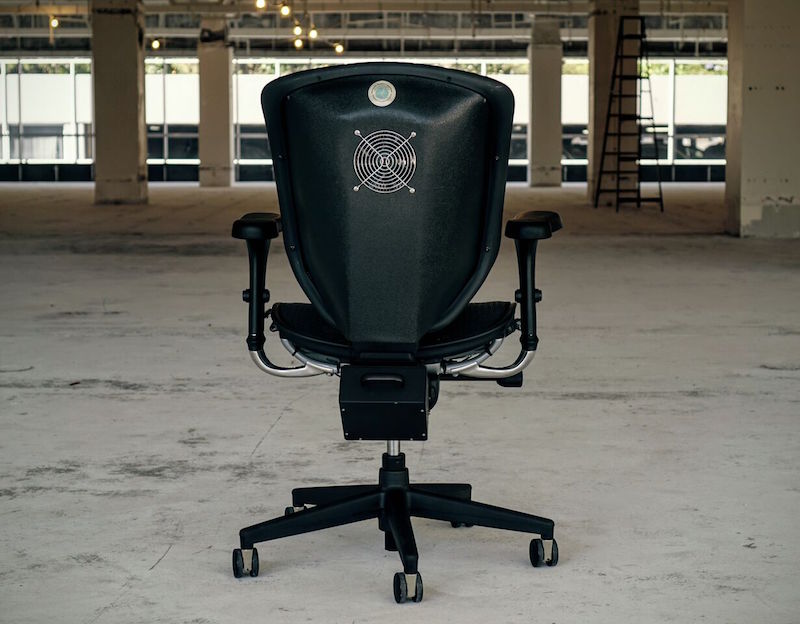Offices can oftentimes turn into a real life Goldilocks tale. One worker may be too hot, while another one is too cold. Meanwhile, a third employee is, you guessed it, just right. It is a question as old as the concept of the office itself: What is the most efficient way to manage the temperature of an office so everyone is comfortable? Like trying to determine if the universe actually is infinite or whether the chicken or the egg came first, it seems to be a problem without an attainable solution. Or is it?
As one startup is asking, what if we have been focused on heating and cooling the wrong thing? After all, it isn’t the room that necessarily needs temperature adjustment, but the bodies within the room. That’s where Personal Comfort Systems' Hyperchair comes into play. It may sound like something an astronaut gets strapped into as part of their training, but for the most part, the Hyperchair looks just like a regular office chair, with one major difference: it can actively heat or cool the person sitting in it.
Developed by researchers at the Center for Built Environment at UC Berkeley, the Hyperchair uses heating tape that is woven into the fabric of the chair to warm the occupant much in the same way a heated car seat works. And for anyone who finds himself or herself running a bit warm on a daily basis, tactically placed fans can be used to wick body heat away like a cool, lakefront breeze. The temperature of the chair can be adjusted either by using the onboard control panel on the side of the seat or by using a smartphone app. The back and the seat of the chair can be adjusted separately, which allows for one to be set on heat while the other is set on cool, just in case you ever find yourself wearing shorts and a parka on the same day.
 Photo Courtesy of Personal Comfort Systems
Photo Courtesy of Personal Comfort Systems
This technology comes at a cost, however, as the chairs range from $1,000 to $1,500 each, depending on the size of the order. And while that is certainly expensive for a chair, the company says this money will be made back in energy savings. In the winter the heat can be turned down a few degrees and the same goes for the air conditioning in the summer.
"If you relax it a couple of degrees, what you're going to find is a 5% to 10% energy savings on the heating and cooling system," Peter Rumsey, Founder and CEO of Personal Comfort Systems, said in an interview with Co. Exist.
The chairs will also be rigged with Wi-Fi and temperature sensors allowing them to communicate with the building regarding various temperature related issues. Additionally, in some climates or in mild seasons such as spring or fall, offices may be able to turn off their thermostats completely and use just the chairs for temperature regulation. With 30% of global carbon emissions coming from building energy consumption, not only can the chairs help with utility costs, but they can also be considered environmentally friendly.
For the time being, the startup is only offering the Hyperchair to large companies, but the hope is that it will eventually be made available for individual orders. The Hyperchair looks to solve a problem that has existed for years while providing everyone with a bit of the Goldilocks treatment of enjoying things that are just right... you know, without all of that breaking and entering business.
 Photo Courtesy of Personal Comfort Systems
Photo Courtesy of Personal Comfort Systems
 Photo Courtesy of Personal Comfort Systems
Photo Courtesy of Personal Comfort Systems
 Photo Courtesy of Personal Comfort Systems
Photo Courtesy of Personal Comfort Systems
 Photo Courtesy of Personal Comfort Systems
Photo Courtesy of Personal Comfort Systems
Related Stories
| Aug 11, 2010
Top of the rock—Observation deck at Rockefeller Center
Opened in 1933, the observation deck at Rockefeller Center was designed to evoke the elegant promenades found on the period's luxury transatlantic liners—only with views of the city's skyline instead of the ocean. In 1986 this cultural landmark was closed to the public and sat unused for almost two decades.
| Aug 11, 2010
200 Fillmore
Built in 1963, the 32,000-sf 200 Fillmore building in Denver housed office and retail in a drab, outdated, and energy-splurging shell—a “style” made doubly disastrous by 200 Fillmore's function as the backdrop for a popular public plaza and outdoor café called “The Beach.
| Aug 11, 2010
Integrated Project Delivery builds a brave, new BIM world
Three-dimensional information, such as that provided by building information modeling, allows all members of the Building Team to visualize the many components of a project and how they work together. BIM and other 3D tools convey the idea and intent of the designer to the entire Building Team and lay the groundwork for integrated project delivery.
| Aug 11, 2010
Inspiring Offices: Office Design That Drives Creativity
Office design has always been linked to productivity—how many workers can be reasonably squeezed into a given space—but why isn’t it more frequently linked to creativity? “In general, I don’t think enough people link the design of space to business outcome,” says Janice Linster, partner with the Minneapolis design firm Studio Hive.
| Aug 11, 2010
Great Solutions: Products
14. Mod Pod A Nod to Flex Biz Designed by the British firm Tate + Hindle, the OfficePOD is a flexible office space that can be installed, well, just about anywhere, indoors or out. The self-contained modular units measure about seven feet square and are designed to serve as dedicated space for employees who work from home or other remote locations.







